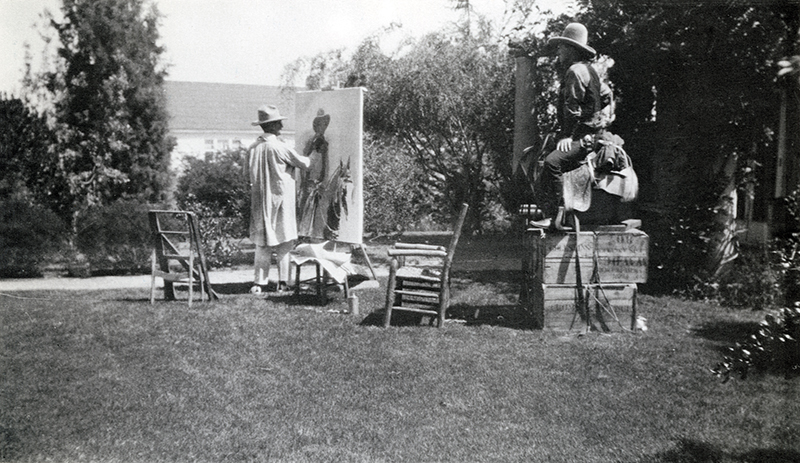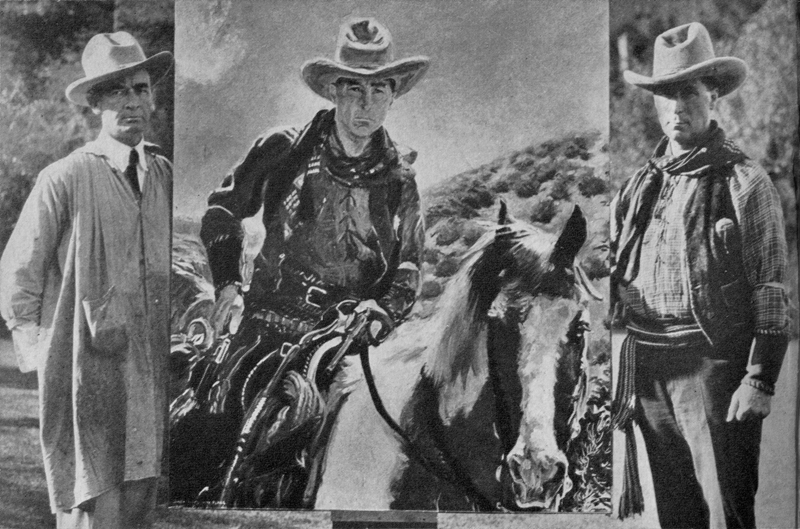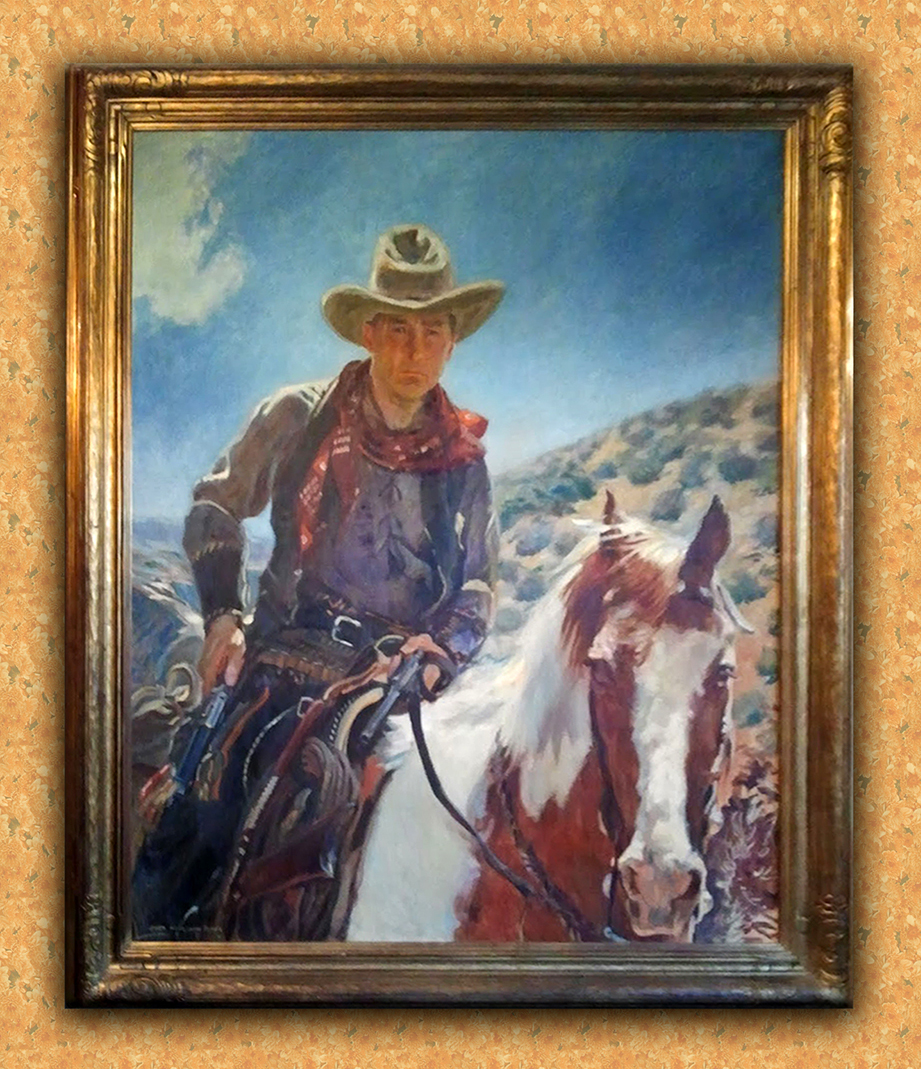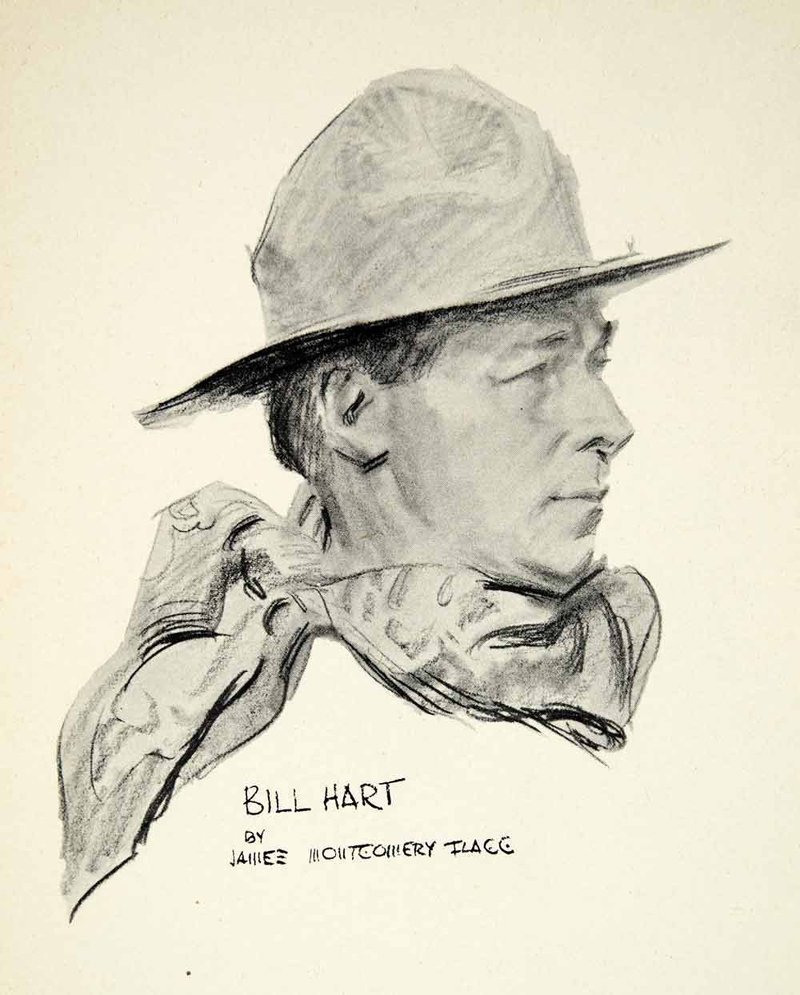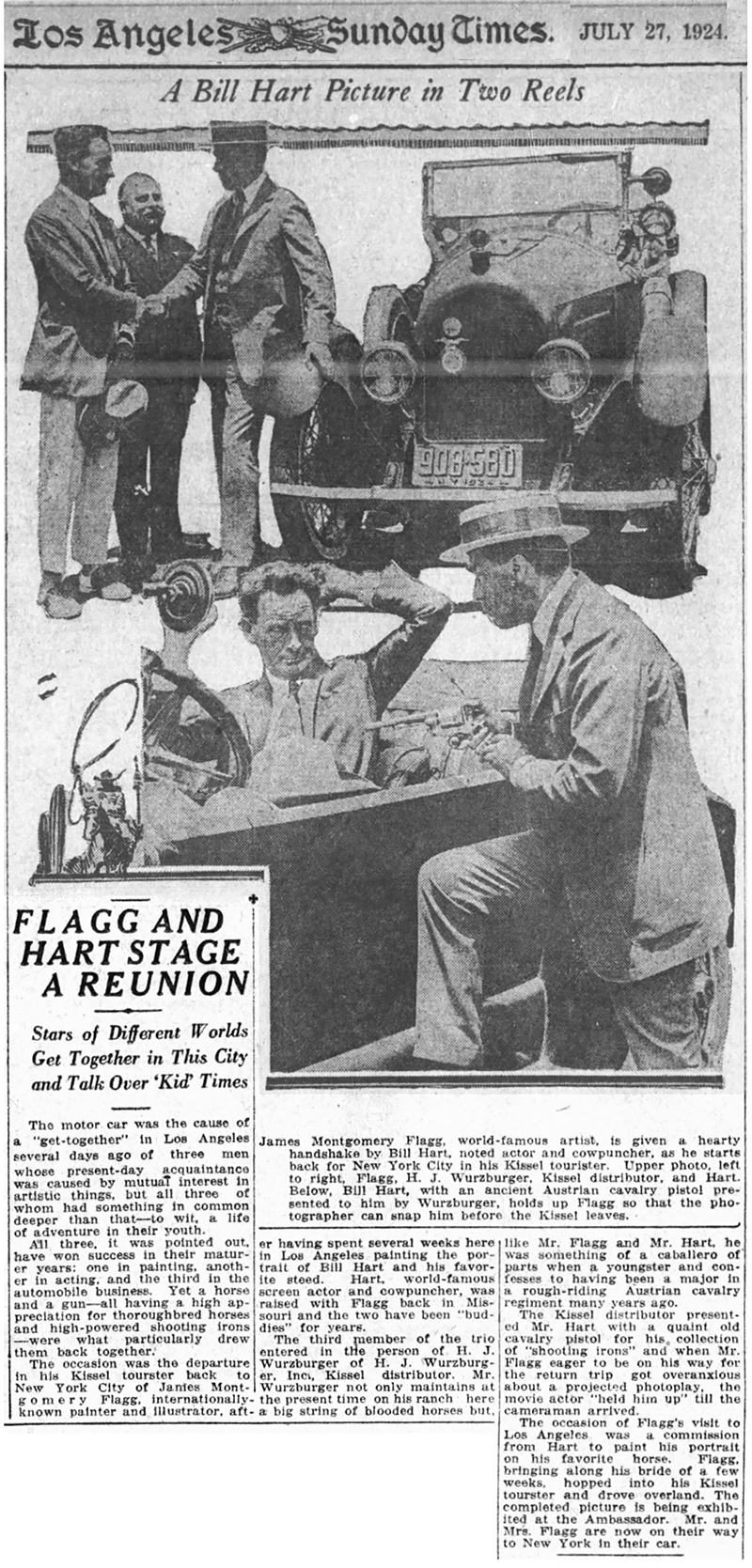|
|

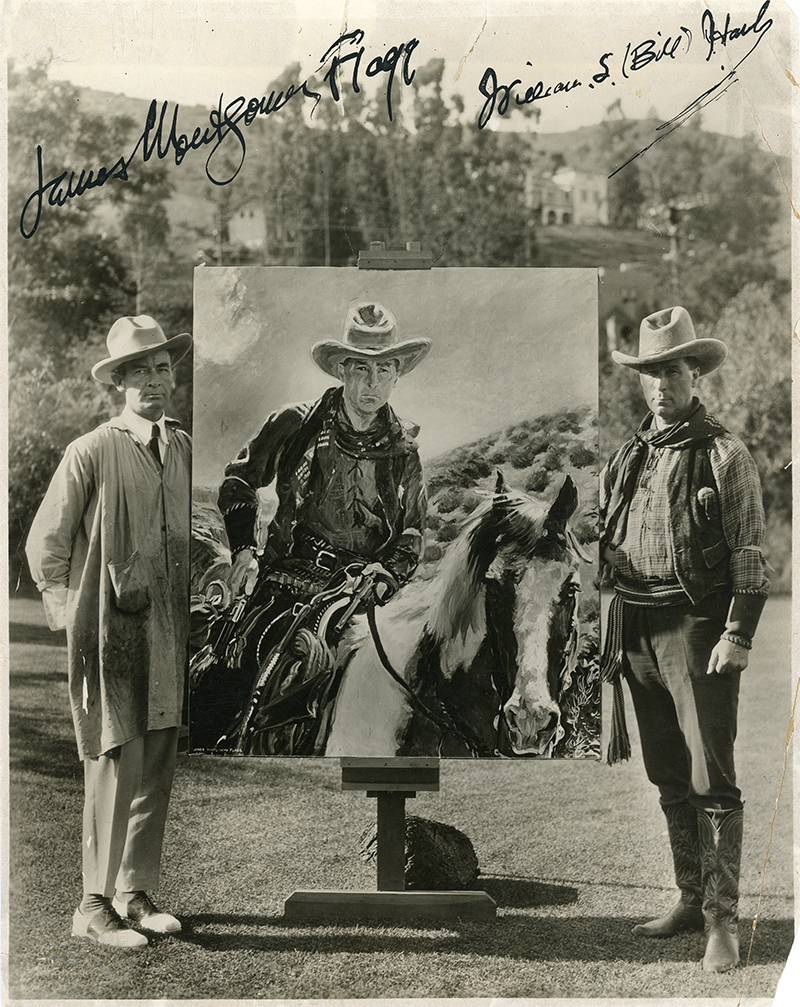
Click image to enlarge
| Download archival scan
Artist James Montgomery Flagg (left) presents his oil painting of William S. Hart astride his horse, Fritz, to the actor at his Hollywood home (8341 De Longpre Avenue, now in the city of West Hollywood), in 1924. Photograph by Tilagg of Hollywood and distributed by Keystone Photo Service, 1231 South Olive Street, Los Angeles. 7.75x9.75 glossy print, autographed by Flagg and Hart. According to the Hart Museum in Newhall, where Flagg's oil panting hangs in the downstairs dining room, the title of the painting is "The Bounty Hunter." According to an early collector of this signed photographic print, the title of the painting is "Without a Warrant" (see collector's notes on back of photograph at bottom). It should be noted the photograph was made in 1924 and the (unknown) collector's notes were written no earlier than 1946. Flagg does not state the name of the painting in his 1925 discussion of his 1924 visit with Hart here or in his 1946 autobiography. Neither does Hart, in his own 1929 autobiography.
Flagg spent several weeks with Hart as he painted the work (see Los Angeles Times below, July 27, 1924). Flagg painted studies of Hart's horse, Fritz, in Newhall; Hart posed for the painting at his Hollywood home by sitting on a whiskey barrel that supposedly predated Prohibition (which took effect in 1920). According to a Flagg biography, "After ten sittings the painting was complete, Hart complaining regularly that his face was tired from holding the ferocious expression for so long" (Meyer, Susan E., "James Montgomery Flagg." New York: Watson-Guptill Publications, 1974, pg. 55.) In a personal letter to Hart in 1926, Flagg expressed his growing displeasure with the portrait and requested a do-over, which never happened. Hart writes in 1929 ("My Life East and West," pp. 336-337):
James Montgomery Flagg came a-honeymooning to my little Hollywood home. Jim had been wanting for years to do an oil painting of my pony and myself, so, planting himself at the wheel of his car and placing his bride beside him, he motored across America. I was sort of in the dumps, and the few weeks that Jim and Dorothy spent with us did me a lot of good. Jim started his painting up at the ranch; but he hadn't squared things with Fritz. A few days of standing still, with me on his back, and the rest of his family standing around making bright remarks, was too much for the little autocrat. He quit cold. Jim had to continue his work at Hollywood. Fortunately, he had put in all of his time working on Fritz and could finish him from memory. But my end of it was not so easy. Instead of a live horse, I got a saw-horse with a pre-Volstead whiskey barrel on top of it. Nothing in the humorous line, from A to Izzard, ever escaped Jim Flagg ... and the all too ludicrous sight of the "bad guy" perched on top of a whiskey barrel kept his keen wit bubbling so much that he was forced to spend his spare moments hiding in a vine-covered pergola where he worked off his mirth on paper; the result being, "Boulevards all the Way Maybe," a rich, whimsical description of his journey through Missouri mud and over Nevada deserts, to find for an inspiration, at the end of his rainbow, a bad man — guns an' all — riding a whiskey barrel on a Hollywood lawn. I can understand Jim's book being a laugh-provoker, but I can't understand why he never used the guns when they were always handy. Davis (2003) adds: "Hart complained that his face was weary from holding a ferocious grimace so long" (pg. 183).
Looking at the two men flanking the portrait, which does the man sitting on the horse more closely resemble? Flagg reproduced a cropped version of this image in his autobiography, "Roses and Buckshot" (G.P. Putnam's Sons, New York, 1946, pg. 112 ff.). It is unknown if Flagg used this exact print, although it would explain the cropping. In the book, Flagg refers to the horse as "Paint." Hart often referred to Fritz as "Paint." Fritz was both a paint (breeding) and a pinto (coloring).
Flagg had previously created a series of illustrations for "Fritz's book," "Told Under a White Oak Tree" (1922). Years later, Flagg would paint a portrait of Hart's sister, Mary Ellen, which hangs in the upstairs living room of the Newhall mansion. In 1951, five years after Hart's death, Flagg drew a sketch of his "pardner" (shown below right). See Also: Artist James Montgomery Flagg writes about William S. Hart, 1925. Letter: Hart Sends Flagg $500 for Portrait of Sister, March 3, 1945. Flagg Painting of Hart's Horse Comes Home After 90-Plus Years, June 29, 2018.
LW2321c: 9600 dpi jpeg from original photograph purchased 2018 by Leon Worden. Documentation on file.
|
Discovery Guide & Map 2017
Last Will & Testament of William S. Hart 1944 Real Estate Acquisitions 1921-Date
Timeline: Operational Management of Museum, 1958/1988
Master Inventory 1971
Inventory: Missing Items 1963/1971
Charles M. Russell Portrait 1908
10 Millionth 'T' 1924
Hart at Ranch ~1920s
Const. 1926-27 x5
Construction 1927
Construction 1927
Flagg Presents Portrait
1930 x2
RPPC ~1930s
Amelia Earhart
Robert Taylor Photo Shoot 1941: BTK Gun, Fritz's Grave (Mult.)
Fire Threatens 1942
With Dan White ~1945
Letter from Hart to Flagg 1945
RPPC ~1950s
Frew Addition 1958
Park Dedication 1958
Dedication 1958
Entrance ~1958
Photo Gallery 1958/61
1959 x3
Bubnash Family Picnic 1959
Brochure 1960s
Visitor at Turret ~1960s
RPPC ~1960s
Times Story 1962
Aerials 1963
Brownie Playday Patch 1967
Dogs' Graveyard, Turret, Fritz's Grave 1967
Interiors 1968 x5
Exteriors, Barnyard 1968 x5
Picnic Grounds Cleanup 1973 (Mult.)
Friends of Hart Park: Initial Bylaws 1981
Donor List: Friends of Hart Park & Museum
Hart's Walk of Stars Plaques
Resolution 1986:
FOHP Founders
Pole Barn ~1998
Let's Go L.A. Video 2013
In Memoriam: Norman the Steer 2005-2017
Reckless Driving Bench 2017
NHMLA Volunteer Honors 2018
|
The site owner makes no assertions as to ownership of any original copyrights to digitized images. However, these images are intended for Personal or Research use only. Any other kind of use, including but not limited to commercial or scholarly publication in any medium or format, public exhibition, or use online or in a web site, may be subject to additional restrictions including but not limited to the copyrights held by parties other than the site owner. USERS ARE SOLELY RESPONSIBLE for determining the existence of such rights and for obtaining any permissions and/or paying associated fees necessary for the proposed use.






